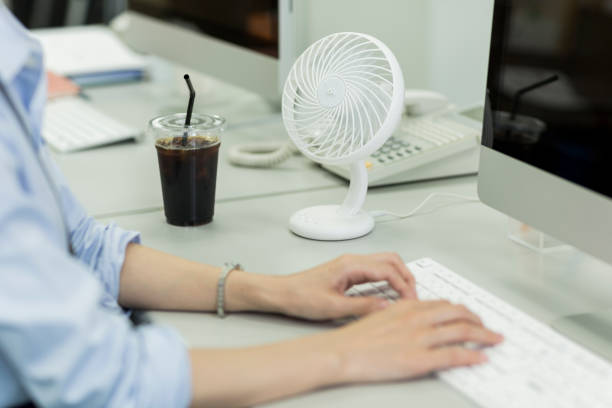Introduction:
In the dynamic and fast-paced world of business, creating an optimal working environment is essential for productivity and well-being. While air conditioning systems play a significant role in maintaining comfort, a desk fan is often the unsung hero, providing targeted and immediate relief to individuals in their workspaces. In this comprehensive guide, we’ll delve into the myriad benefits, considerations, and strategies for getting down to cool business with a desk fan, exploring how this seemingly humble appliance can make a substantial impact on both comfort and efficiency in the workplace.
The Power of Personal Cooling:
- Localized Comfort:Desk fans are designed to deliver localized cooling, providing a refreshing breeze directly to the user. In bustling office spaces or home offices, where individuals may have varying temperature preferences, a desk fan allows for personalized comfort without affecting the entire room. This targeted approach ensures that individuals can maintain their ideal temperature without the need for adjusting central air conditioning settings.
- Energy Efficiency:One of the standout features of desk fans is their energy efficiency. Compared to large HVAC (Heating, Ventilation, and Air Conditioning) systems that cool entire rooms, desk fans consume significantly less energy. This not only contributes to cost savings but also aligns with sustainable and eco-friendly practices, making desk fans a practical choice for those seeking efficient cooling solutions with a smaller environmental footprint.
- Immediate Relief:Unlike central air conditioning, which may take time to cool down a space, desk fans provide immediate relief. Whether you’ve just stepped into the office on a warm day or are engaged in a high-intensity work task, the instant breeze from a desk fan can quickly alleviate discomfort and create a more conducive environment for focus and productivity.
Types of Desk Fans and Their Features:
- Traditional Oscillating Fans:Traditional oscillating fans are a familiar sight in offices and homes. They feature a rotating head that moves side to side, distributing air evenly across a room or a designated area. The oscillation function ensures that a broad section of the room receives a constant flow of air, making them suitable for shared workspaces.
- USB-Powered Fans:USB-powered desk fans are a modern and portable solution for personal cooling. These compact fans can be powered by connecting them to a computer, laptop, or a portable power bank through a USB port. Ideal for small desk spaces or on-the-go use, USB-powered fans offer flexibility and convenience.
- Tower Fans:Tower fans are tall, slim units that provide vertical airflow. They are designed to take up minimal floor space while delivering efficient cooling. Many tower fans come with additional features such as customizable speed settings, timers, and even air purifying functions, making them versatile and suitable for various office setups.
- Clip-On Fans:For individuals with limited desk space, clip-on fans offer a practical solution. These fans can be attached to the edge of a desk or table, providing a compact and unobtrusive cooling option. The adjustable clip allows users to direct the airflow precisely where it is needed.
Considerations When Choosing a Desk Fan:
- Size and Placement:Consider the size of your workspace when choosing a desk fan. Compact desks may benefit from smaller, portable fans, while larger workstations or shared offices may require larger oscillating fans or tower fans. Additionally, think about the placement of the fan to ensure optimal airflow without causing disruptions.
- Adjustable Speed and Oscillation:Customizability is a key factor in the effectiveness of a desk fan. Look for fans with adjustable speed settings to tailor the airflow to your comfort level. Oscillation features, which allow the fan head to move horizontally, enhance the distribution of cool air across the room.
- Noise Level:In a quiet office environment or during important meetings, a noisy fan can be distracting. Consider the noise level of the desk fan, especially if you value a quiet workspace. Many modern desk fans are designed with noise reduction features to provide effective cooling without causing disruptions.
- Energy Efficiency and Sustainability:Opt for desk fans that prioritize energy efficiency. Look for models with the ENERGY STAR label, indicating compliance with energy efficiency standards. Additionally, consider the materials used in the construction of the fan, opting for sustainable and recyclable options when possible.
Creating an Optimal Cooling Strategy:
- Strategic Placement:Experiment with the placement of your desk fan to achieve optimal cooling. Consider placing the fan in a position where it can draw in fresh air from an open window or doorway. Additionally, position the fan to create cross-ventilation if possible, enhancing the overall cooling effect.
- Complementary Cooling with Air Conditioning:Desk fans can complement central air conditioning systems effectively. By strategically placing desk fans near workstations, individuals can enjoy personalized cooling without relying solely on the air conditioning system. This collaborative approach allows for greater control over comfort levels while minimizing overall energy consumption.
- Personal Comfort Accessories:In addition to using a desk fan, consider incorporating personal comfort accessories. A small desktop humidifier can add moisture to the air, preventing dryness, while a miniature fan with a mister function can provide a cooling mist for additional relief during warmer days.
- Time-Sensitive Cooling:Implement time-sensitive cooling strategies based on your work schedule. If you have specific hours of intense concentration or virtual meetings, use the desk fan strategically during these times to create a more comfortable working environment. Adjust the fan settings based on the natural temperature fluctuations throughout the day.
Maintenance and Care Tips:
- Regular Cleaning:Desk fans, like any electronic appliance, benefit from regular cleaning. Dust and debris can accumulate on fan blades, affecting performance and air quality. Clean the blades and housing of your desk fan periodically to ensure optimal functionality and prevent the circulation of dust in your workspace.
- Check and Tighten Components:Over time, the components of a desk fan may loosen due to vibrations. Periodically check and tighten screws, nuts, and other fasteners to maintain the structural integrity of the fan. This simple maintenance task contributes to the longevity and reliability of the appliance.
- Store Properly When Not in Use:If you use your desk fan seasonally, store it properly during periods of non-use. Clean the fan, wrap the power cord securely, and store it in a cool, dry place to prevent dust accumulation and potential damage. Proper storage ensures that the fan is ready for use when needed.
Conclusion: Harnessing the Cooling Power of Desk Fans
In the realm of business, where efficiency and comfort converge, desk fans and led lights emerge as indispensable tools for creating a conducive working environment. From traditional oscillating fans to modern USB-powered options, the variety of desk fans available caters to diverse preferences and needs. By strategically integrating a desk fan into your workspace and adopting personalized cooling strategies, you can enhance comfort, improve focus, and contribute to energy efficiency.
So, whether you’re working in a bustling office or cultivating a productive home office, getting down to cool business with a desk fan is a practical and effective approach to achieving a refreshing and comfortable work atmosphere. Explore the features, choose the right type for your space, and experience the immediate impact of a well-placed desk fan on your daily work routine.



